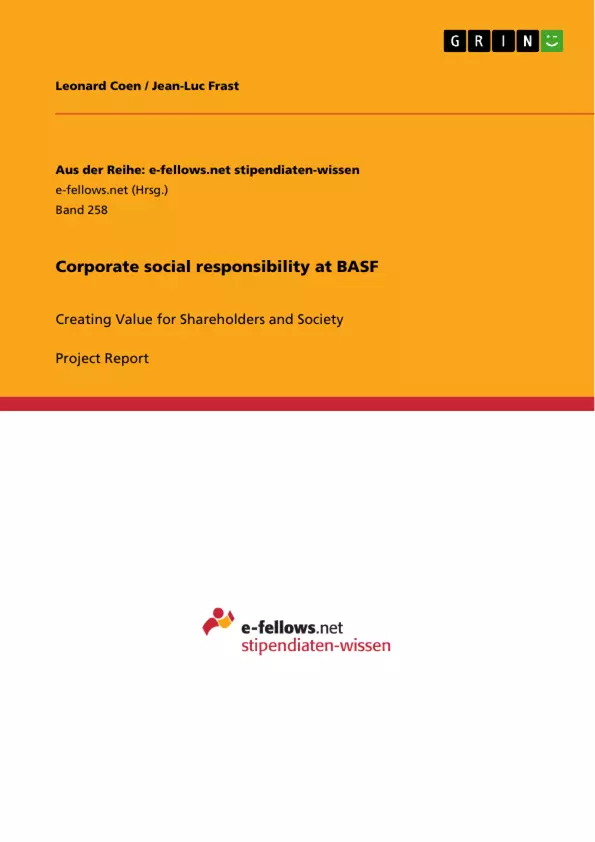The most recent publication by Porter and Kramer (2011) reaffirms this theory and expands it from merely environmental concerns to overall societal concerns, in addressing economic growth in the framework of the creation of shared value. Beyond the emphasis on the elimination of inefficiencies in production processes as described in Green and Competitive, Porter and Kramer assess that shared value is created by reconceiving products and markets, redefining productivity in the value
chain, and building supportive industry clusters at the company’s locations.
In the following section we will scrutinize the efforts undertaken by the chemical giant BASF with regard to its Corporate Social Responsibility strategy, relevant policies and initiatives implemented.
Inhaltsverzeichnis (Table of Contents)
- Introduction
- BASF - The Chemical Company
- BASF's Corporate Social Responsibility Strategy
- CSR Implementation at BASF
Zielsetzung und Themenschwerpunkte (Objectives and Key Themes)
This synopsis aims to analyze the Corporate Social Responsibility (CSR) strategy of BASF, a leading chemical company, and how it has been integrated into the company's business model. The analysis will explore BASF's CSR initiatives, policies, and practices in light of theoretical frameworks and relevant research.
- The role of CSR in the chemical industry and its impact on stakeholder relationships
- The business case for CSR and the creation of shared value
- The implementation of CSR through organizational structure, codes of conduct, and stakeholder engagement
- The importance of aligning CSR with business strategy and core values
- The contribution of BASF's CSR strategy to its overall sustainability performance
Zusammenfassung der Kapitel (Chapter Summaries)
- Introduction: This section provides an overview of the global chemical industry, highlighting its growth potential and challenges related to environmental and social impacts. It introduces key concepts such as the business case for CSR and the creation of shared value, drawing on works by Porter and Kramer.
- BASF - The Chemical Company: This chapter presents BASF's core business, its global reach, and its financial performance. It introduces the company's ambition to fully integrate CSR into its business model, signaling its commitment to sustainability.
- BASF's Corporate Social Responsibility Strategy: This section explores BASF's CSR strategy, outlining its three levels of impact (risk minimization, business enhancement, and business generation). It highlights BASF's commitment to triple bottom line improvements and its adherence to international sustainability reporting guidelines. The chapter also discusses the company's adoption of a clear CSR language and its alignment with global capital market expectations.
- CSR Implementation at BASF: This final chapter delves into the practical aspects of implementing BASF's CSR strategy. It discusses the importance of stakeholder engagement, the establishment of community advisory panels, and the company's commitment to continuous improvement. The chapter highlights BASF's organizational structure, its code of conduct, and its leadership in promoting CSR within the industry. It concludes with a focus on BASF's commitment to sustainability and its recognition as a leader in CSR.
Schlüsselwörter (Keywords)
This synopsis focuses on the key concepts of Corporate Social Responsibility (CSR), shared value creation, sustainability, stakeholder engagement, and organizational structure within the context of the chemical industry. The analysis explores the specific case of BASF, a leading chemical company, and examines its commitment to integrating CSR into its business model and operations. The analysis draws on frameworks developed by Porter and Kramer, while exploring BASF's contributions to the field of sustainable development.
- Citar trabajo
- Leonard Coen (Autor), Jean-Luc Frast (Autor), 2011, Corporate social responsibility at BASF, Múnich, GRIN Verlag, https://www.grin.com/document/179610



